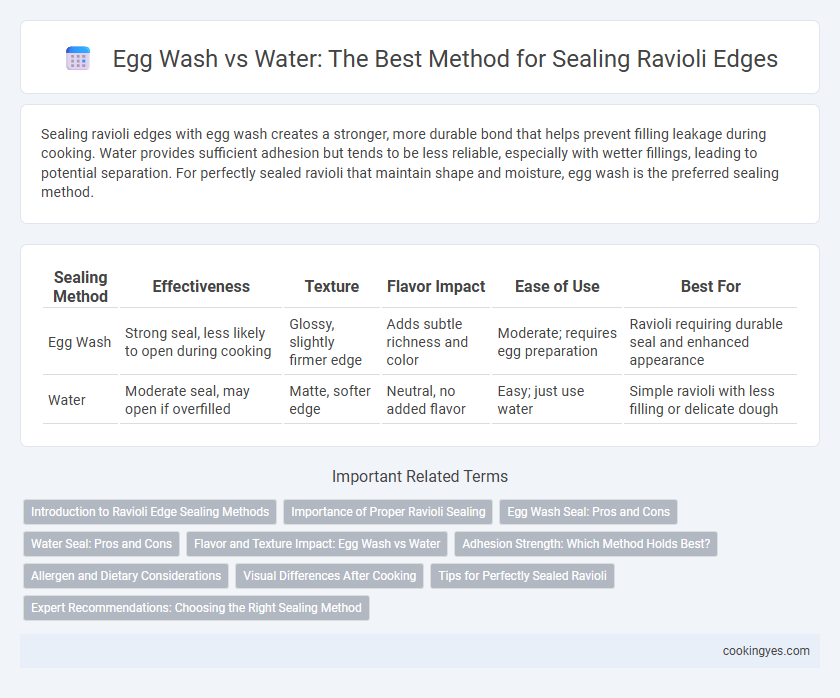Sealing ravioli edges with egg wash creates a stronger, more durable bond that helps prevent filling leakage during cooking. Water provides sufficient adhesion but tends to be less reliable, especially with wetter fillings, leading to potential separation. For perfectly sealed ravioli that maintain shape and moisture, egg wash is the preferred sealing method.
Table of Comparison
| Sealing Method | Effectiveness | Texture | Flavor Impact | Ease of Use | Best For |
|---|---|---|---|---|---|
| Egg Wash | Strong seal, less likely to open during cooking | Glossy, slightly firmer edge | Adds subtle richness and color | Moderate; requires egg preparation | Ravioli requiring durable seal and enhanced appearance |
| Water | Moderate seal, may open if overfilled | Matte, softer edge | Neutral, no added flavor | Easy; just use water | Simple ravioli with less filling or delicate dough |
Introduction to Ravioli Edge Sealing Methods
Sealing ravioli edges with egg wash creates a stronger, more durable bond due to the protein content that acts as a natural adhesive, ensuring the filling stays securely inside during cooking. Water sealing softens the pasta dough slightly, allowing it to stick together but may result in a less reliable seal, especially for fillings with high moisture content. Choosing the right sealing method affects the texture and integrity of ravioli, influencing overall cooking performance and final dish quality.
Importance of Proper Ravioli Sealing
Proper ravioli sealing is crucial to prevent filling leakage during cooking, ensuring a perfect, intact pasta. Using egg wash strengthens the edges by creating a sticky, durable bond that resists boiling water, while water offers a temporary seal but may cause the ravioli to open more easily. Chef experts recommend egg wash for a reliable seal, essential for maintaining the ravioli's texture and flavor balance.
Egg Wash Seal: Pros and Cons
Sealing ravioli edges with egg wash creates a stronger, more durable bond that reduces the risk of filling leakage during cooking. The protein in the egg wash acts as an adhesive, producing a glossy finish and enhancing the overall presentation of the pasta. However, excessive use of egg wash may make the dough edges too stiff or interfere with the texture, and it requires careful application to avoid altering the flavor.
Water Seal: Pros and Cons
Sealing ravioli edges with water creates a simple, effective bond that prevents filling leakage during cooking while maintaining the dough's delicate texture. This method is easy to apply and avoids adding extra fat or altering flavor, making it ideal for thin or delicate pasta doughs. However, water may not form as strong a seal as egg wash, increasing the risk of edges opening if the dough is too thick or overfilled.
Flavor and Texture Impact: Egg Wash vs Water
Sealing ravioli edges with egg wash creates a rich, slightly glossy finish that enhances both flavor and texture by adding a subtle eggy taste and a firmer, more adhesive seal. Using water for sealing results in a neutral flavor profile and a softer, less durable edge that may be prone to opening during cooking. Egg wash provides a more resilient bond, improving the overall cooking experience and maintaining the ravioli's shape without compromising taste.
Adhesion Strength: Which Method Holds Best?
Sealing ravioli edges with egg wash provides stronger adhesion than water due to the protein content in egg acts as a natural adhesive that creates a more secure bond. Water seals by hydrating the pasta dough but tends to weaken once cooked, increasing the risk of filling leakage. Professional chefs often prefer egg wash to ensure durable, tightly sealed ravioli that maintain shape and texture during boiling.
Allergen and Dietary Considerations
Sealing ravioli edges with egg wash enhances binding due to the protein content but introduces allergens like eggs, making it unsuitable for those with egg allergies or vegan diets. Using water for sealing is a hypoallergenic alternative that avoids egg allergens and accommodates vegan and allergen-sensitive diets, though it may result in a less secure seal. For gluten-free or low-protein pasta dough, water sealing provides a safer option without compromising dietary restrictions.
Visual Differences After Cooking
Sealing ravioli edges with egg wash creates a golden, glossy finish that enhances the visual appeal after cooking, making the seams more pronounced and aesthetically pleasing. In contrast, sealing with water results in a more matte and subtle edge, often blending with the pasta, which may be less visually distinct. Both methods ensure secure closure, but egg wash offers a more vibrant and polished look.
Tips for Perfectly Sealed Ravioli
Sealing ravioli edges with egg wash creates a stronger, more flexible bond due to the protein content in the eggs, which helps prevent filling leakage during cooking. Water can be used as a cheaper and quicker alternative, but it often results in a weaker seal and potential gaps. For perfectly sealed ravioli, lightly brush the edges with a thin layer of beaten egg, ensuring no excess is left, then firmly press together and crimp the edges to lock in the filling securely.
Expert Recommendations: Choosing the Right Sealing Method
Experts recommend using egg wash for sealing ravioli edges to ensure a stronger, more durable bond that prevents filling leakage during cooking. Egg wash creates a protein-rich adhesive that dries quickly and withstands boiling, while water often results in weaker seals prone to opening. For optimal texture and retention of fillings, professional chefs prioritize egg wash over water when sealing ravioli.
Sealing with egg wash vs Sealing with water for ravioli edges Infographic

 cookingyes.com
cookingyes.com